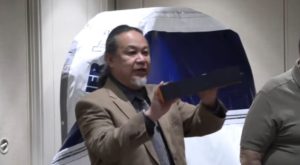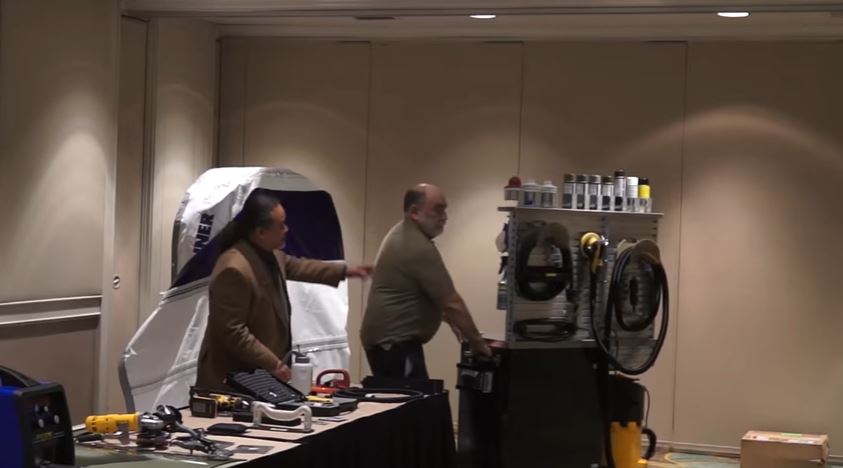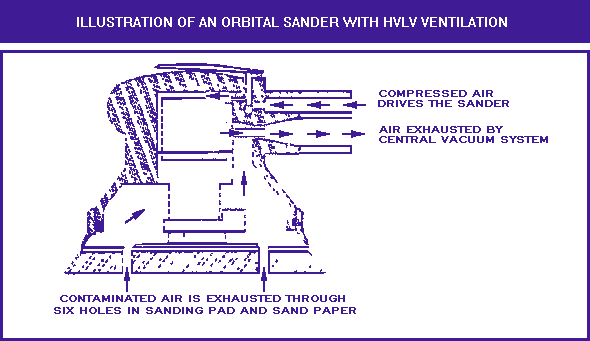
Repairers: Availability of vacuum sanding tech means days of dusty body shop must end
By onBusiness Practices | Education | Repair Operations | Technology
SCRS Vice President Kye Yeung and fellow education committee leader Toby Chess last month warned auto body shop owners to take shop cleanliness and the health risk of particulate matter like “Bondo dust” seriously.
Besides the health risks, it just “makes a mess of everything,” Chess (Kent Automotive) said of body filler residue at a Jan. 11 Society of Collision Repair Specialists open board meeting. The pair repeated their message to the Collision Industry Conference later that week.
“We need to move up the next level,” Chess said. “And that’s managing our employee’s health and also the cleanliness of the shop”
Get 2017 auto body ‘Kool Tools’ recommendations from SCRS; see video of gear in action
The duo’s “Kool Tools” presentation warned about the existence of the solvent styrene in body filler and, like isocyanates, the potential for repeated exposure to increase sensitivity:
The application of filler material can expose you to some hazardous materials if you do not take appropriate precautions. Most body fillers contain a solvent called styrene. As the filler dries, styrene is released to the air and you can breathe it. It has a characteristic sweet smell at low concentrations and a sharp disagreeable odor at high concentrations.
Exposure to styrene can cause respiratory irritation. It may also damage your liver and possibly cause cancer at very high levels of exposures – not usually found in autobody shops. Styrene can also be absorbed directly through the skin if you come in direct contact with the uncured filler. In some people, direct contact with the filler may cause skin rashes and repeated exposure may increase your sensitivity. (Emphasis Yeung and Chess’.)
Yeung and Chess recommended that body technicians wear eye protection and styrene-resistant gloves, and anyone sensitive to the odors should wear a respirator with organic vapor cartridges — taking care to swap them out consistently and anytime the styrene can be smelled. Filler itself should only be mixed and applied somewhere like a prep station where the ventilation can pull the vapors away from the body tech and everyone else, according to the presentation.
Finally, technicians should wash their hands and other exposed skin after applying body filler, the pair suggested.
Sanding itself also raises concerns about employees breathing or ingesting dust.
Sanding paint and filler material creates a lot of fine dust that is easily inhaled and can irritate your breathing tubes and eyes. The dust may contain hazardous substances as well, such as lead, chromium, and the abrasives from sanding disks. This dust can be harmful if inhaled or ingested. We are not suggesting that anyone eats the dust on purpose, but it can easily stick to your hands and face, and if not thoroughly washed off, will contaminate your food, drinks and cigarettes. At even very low levels of exposure, the toxic metals in this dust can cause serious health affects and body workers performing these tasks without precautions have exceeded the exposure limits for these hazardous materials
Yeung (European Motor Car Works) said he was happy to see at SEMA the number of “brand” companies offering portable vacuum sanding systems, which can be married to a portable sanding equipment cart like the Time Shaver option featured in the presentation.

Here’s the 3M-Festool option Yeung mentioned while discussing SEMA’s wares. The video also highlights — perhaps a bit melodramatically, but hey, it’s an ad — some of the health and work quality considerations related to dust:
Other sanding equipment such as Dynabrade’s electronic sanders and Eurovac’s hand sanders was also compatible with vacuum hoses, he said.
Given the health risks and the existence of such convenient options, “there’s no excuse why a body shop should have dust flying all over,” Yeung said.
Curtailing dust with vacuum technology goes back at least two decades before SEMA 2016. A 1996 National Institute for Occupational Safety and Health publication promotes such “ventilated sanders” specifically to protect auto body employees:

“(High-velocity, low-volume) ventilated sanders have cut total dust concentrations to one-tenth the levels produced using unventilated sanders,” NIOSH wrote.
The research entity argued that the price difference for a vacuum-capable sander was “minor,” though it somewhat contradicts itself by then describing “substantial” startup costs for a central vacuum system. However, as Yeung described, the new breed of options are portable, potentially eliminating those infrastructure costs.
Plus, as NIOSH observed, a bunch of dust flying around can lead to either a painter and or shop’s profits being flushed away on redos. Vaccuum options might ultimate pay for themselves. (Not to mention the cost of any regulatory penalties or lawsuits from an unsafe workplace.)
“Use of ventilated sanders can be enhanced by making them convenient to use, for example by installing retractable, flexible hosing attached to a central vacuum system,” NIOSH wrote. “Although initial costs for this system including an air mover, air cleaners, and duct work can be substantial, the system will help eliminate expensive repaints, shorten clean up time, and extend sandpaper life. Workers prefer using these HVLV sanders and also reported their use results in a cleaner shop.”
More information:
“SCRS Education Committee Presents – Kool Tools from 2016 SEMA Show”
Society of Collision Repair Specialists via YouTube, Feb. 18, 2017
SCRS, Jan. 11, 2017
“Control of Dusts From Sanding in Autobody Repair Shops”
National Institute for Occupational Safety and Health, 1996
Images:
SCRS Vice President Kye Yeung last month warned auto body shop owners to take shop cleanliness and the health risk of particulate matter like “Bondo dust” seriously. He recommended vacuum-capable sanders such as this block sander from Eurovac. (Screenshot from SCRS video on YouTube)
SCRS Vice President Kye Yeung and collision repair guru Toby Chess last month warned auto body shop owners to take shop cleanliness and the health risk of particulate matter like “Bondo dust” seriously. They recommended using convenient vacuum sanding technology, like this one married to a Time Shaver cart. (Screenshot from SCRS video on YouTube)
A 1996 National Institute for Occupational Safety and Health publication promotes “ventilated sanders” specifically to protect auto body employees. (Provided by NIOSH)
